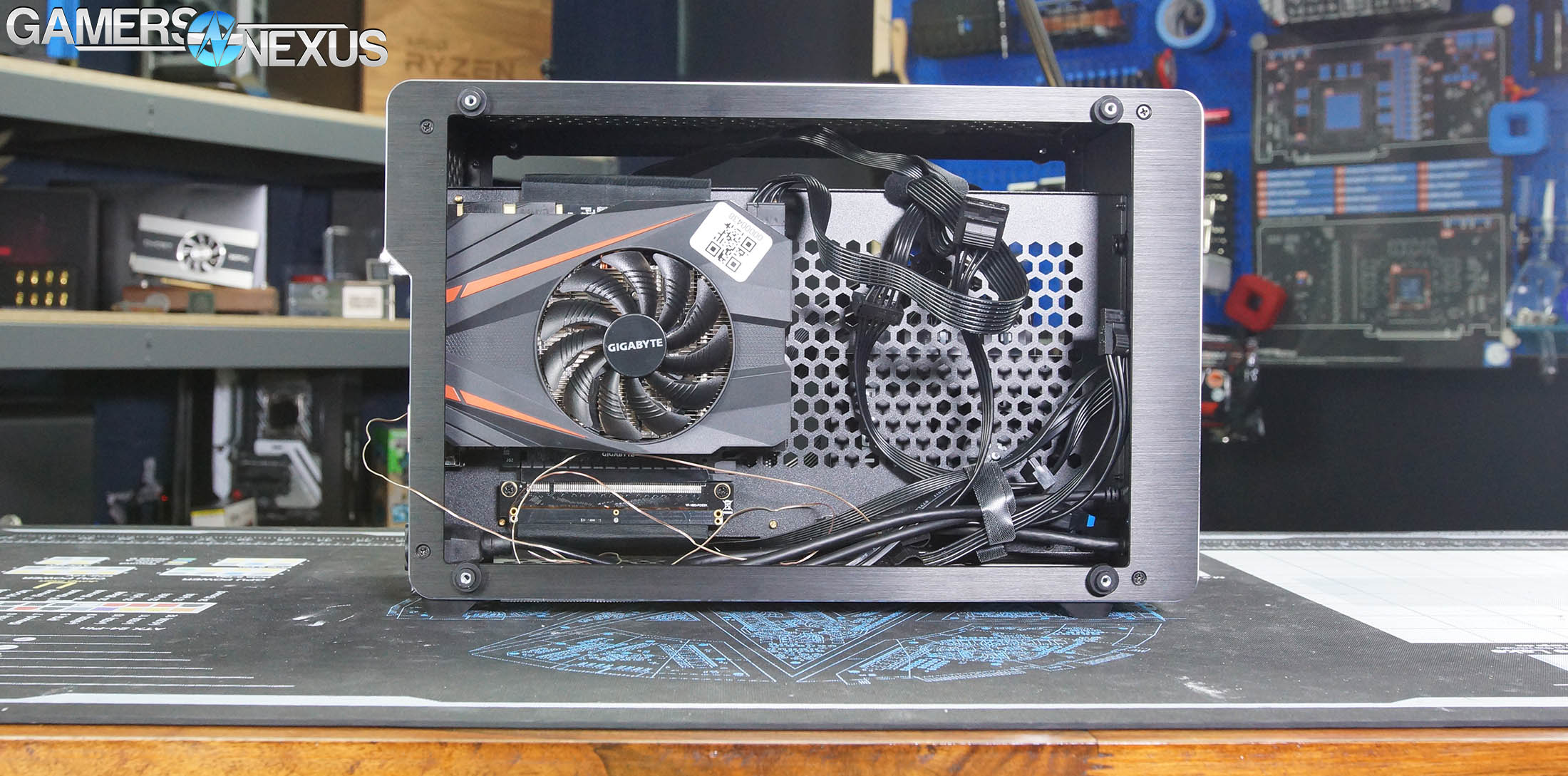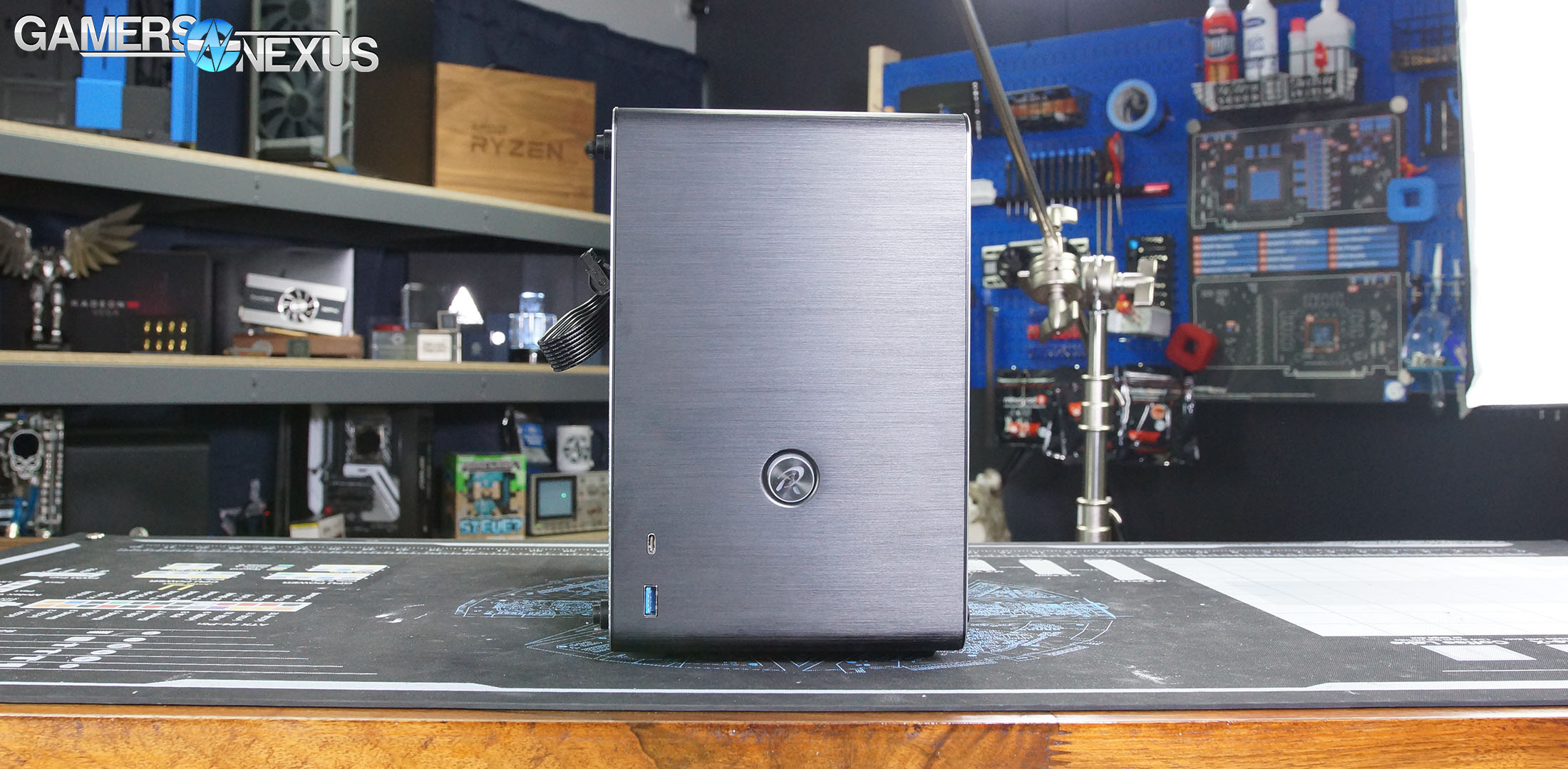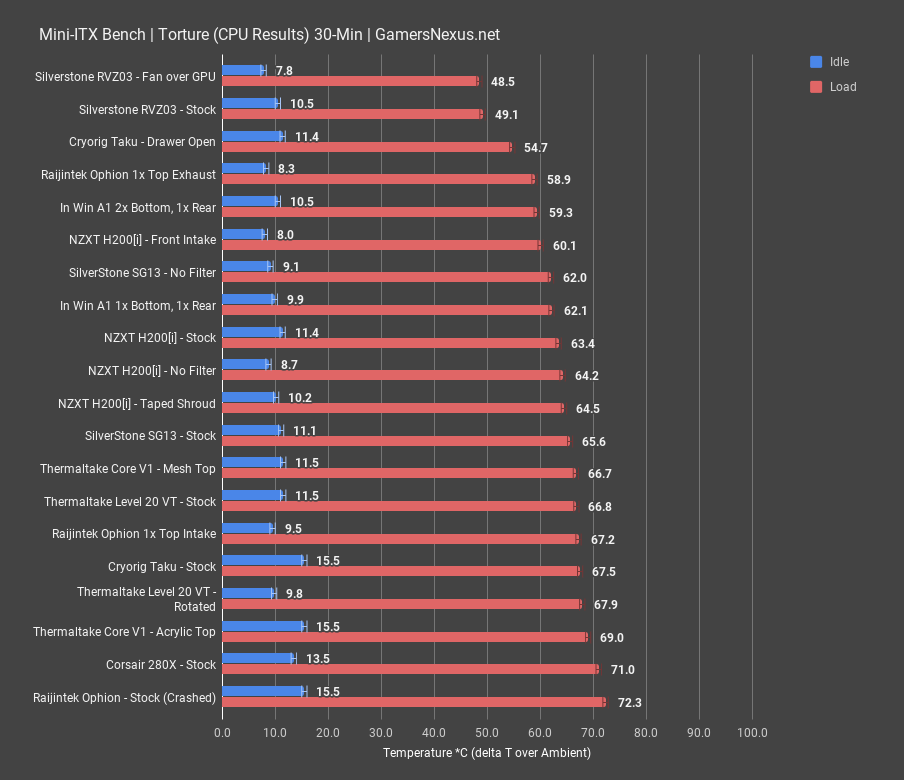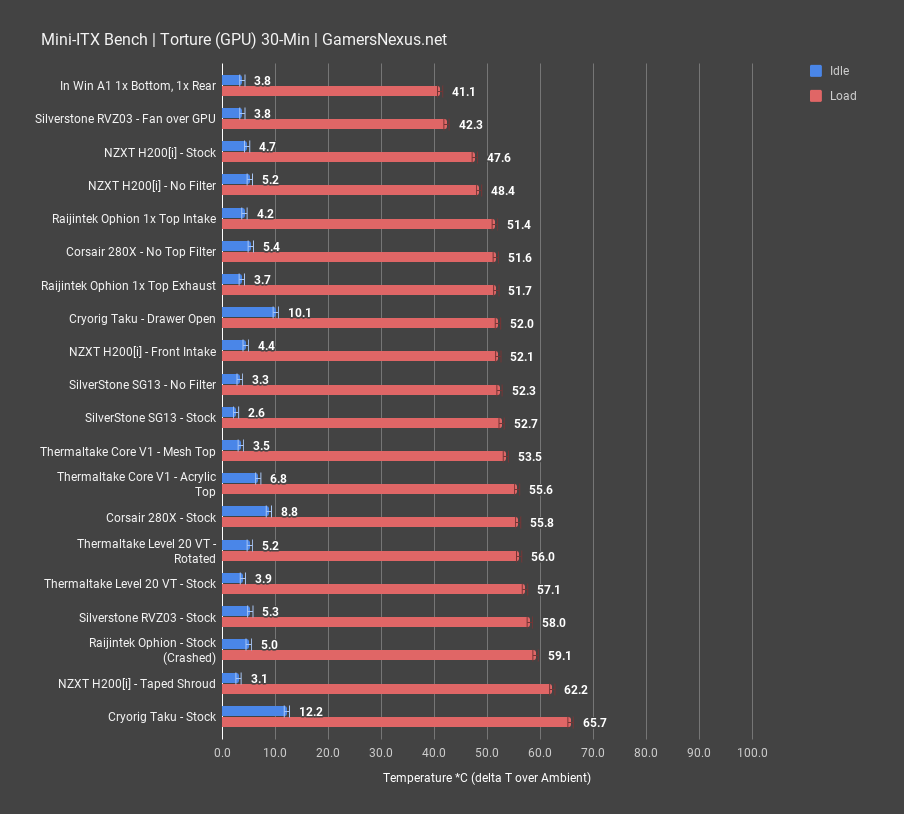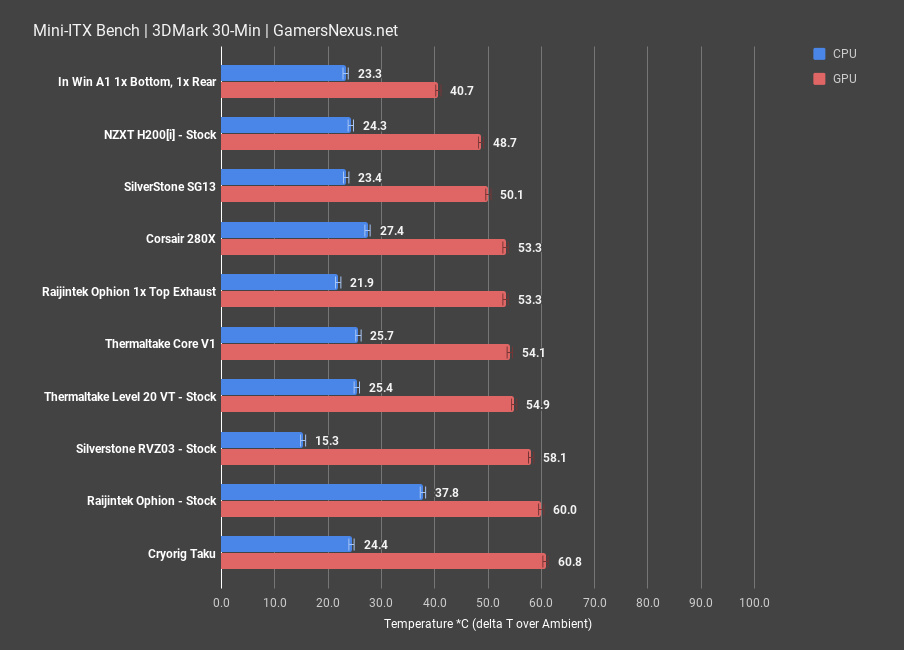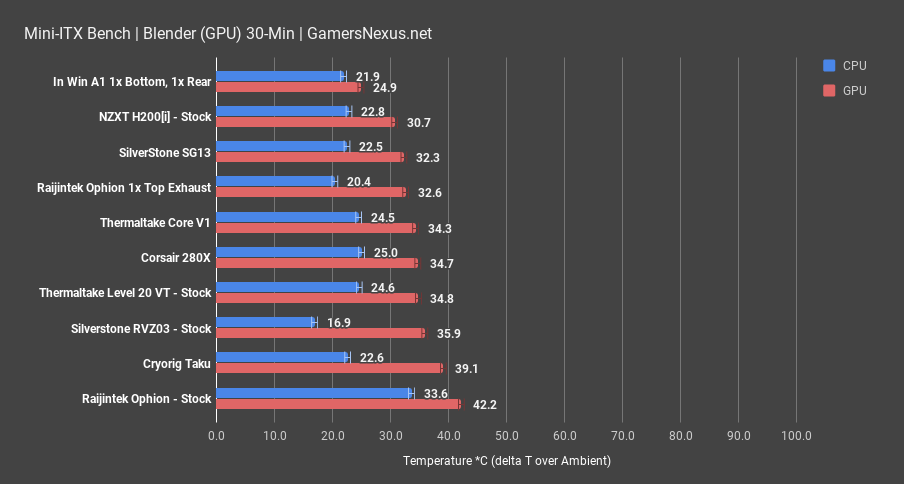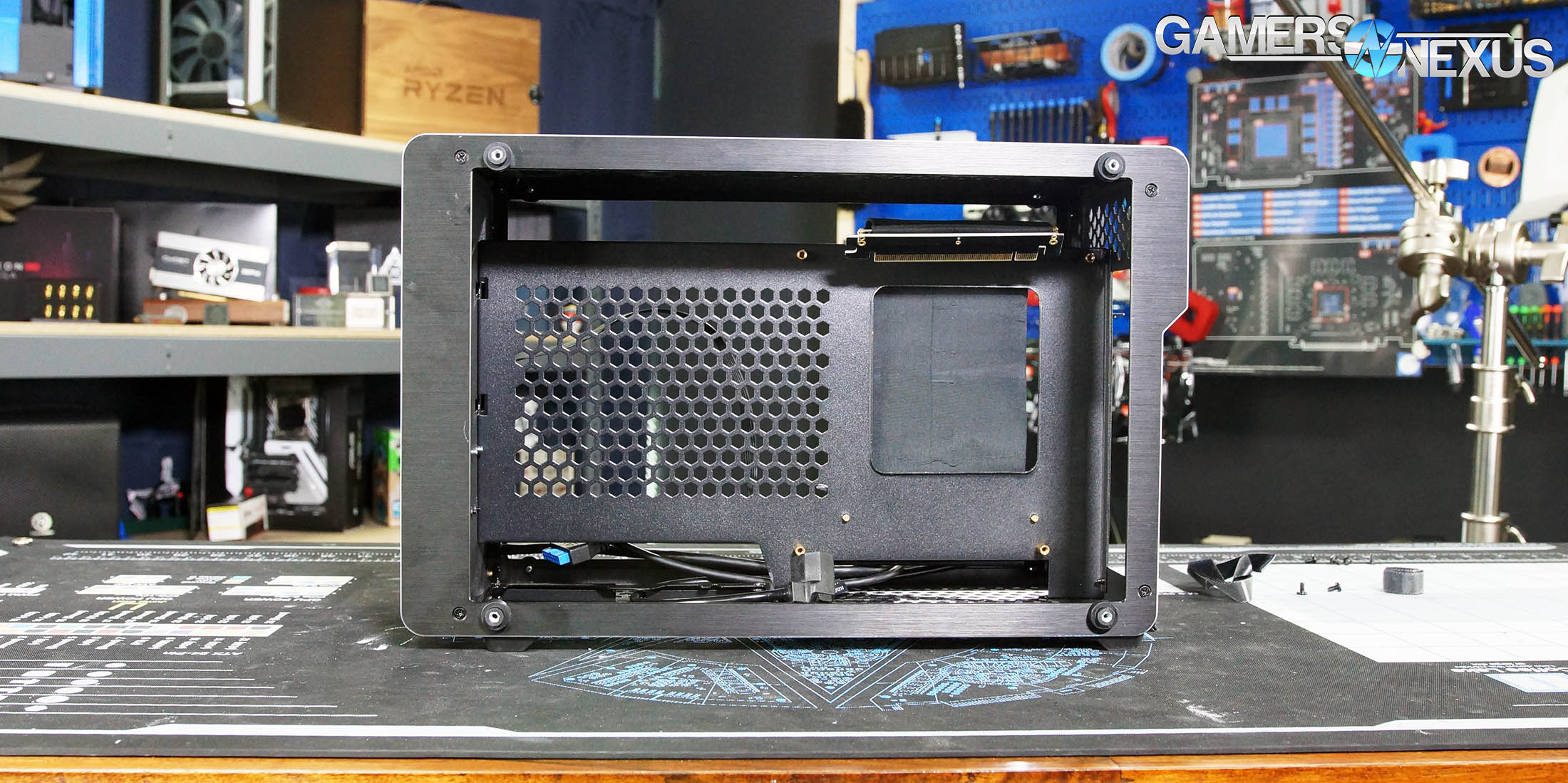This review has been a long time coming, since testing coincided with the busiest part of our office move. We last mentioned the Ophion (and the larger Ophion Evo) in our June roundup of the best cases at Computex. The impression we got back then was that the tempered glass was for show and that Raijintek was considering better-ventilated side panels for the release version. There have been some changes made, but they’re not quite what we expected.
Today’s review looks at the Raijintek Ophion mini-ITX case for build quality, form factor / usable area, thermals, and cable management.
Raijintek Ophion Specs
Product Name | OPHION |
Product Number | 0R20B00097 |
Dimension [W×D×H] | 174×375×245 mm |
Weight | 3.14 kg [N.W.] 3.75 kg [G.W.] |
Material | Aluminum 2.0mm; SPCC 0.8mm |
Color | Coating Black |
M/B Support | MINI ITX |
Drive Bay | Internal 3.5" × 1 + 2.5" × 1 or 2.5" × 3 |
Expansion Slot | PCI Slots ×2 |
I/O Panel | USB3.0×1, C-TYPE×1 |
Power Supply | PS/2 [Internal Bottom-mount] |
Cooling System | Top Fan: 120mm×2 [Option] Bottom Fan: 120mm×1 [Option] |
CPU Cooler Height | 90mm [Max.] |
Graphic Card Length | 330mm [Max.] |
Side Panel Style | 3.0mm Tempered Glass |
Riser Card Adapter | PCI Express 16X Gen3.0 |
Raijintek Ophion Build & Cable Management
First off, both side panels are glass. The Ophion cases were labeled “M-ITX Case, Tempered Glass” at Computex, so there may have been a misunderstanding about intended changes. As for what has changed, there are significantly larger standoffs holding the glass panels away from the side of the case than there were at the show. This is a feature we’ve seen the View 71 and some other tempered glass cases adopt to improve cooling without significantly altering basic structure.
Also new is a kit of adhesive foam filter strips to be packed around the edges of the panels, which largely defeats the purpose of leaving a gap. The strips are only useful in a negative pressure system anyway, and in a negative pressure system every gap would need to be covered in order to filter dust effectively. At that point it would be easier to just remove the standoffs and install the glass panels flush (which is possible). The filter strips are optional, so we left them in the box.
The GPU riser cable is the case’s biggest weak point. The card must be oriented pins-down, while the motherboard must be oriented slot-up. There’s no good diagram showing how to actually install the cable, so we’ll do our best to describe: the cable connects to the GPU, goes down through the slot underneath the motherboard, bends 180 degrees and travels upwards through the gap between the motherboard and the motherboard tray, and finally curls 270 degrees over the top of the motherboard and into the PCIe slot. There isn’t much slack, and it has to make some unpleasantly sharp turns. In addition, since our Cryorig C7 cooler has a chunky bracket that already uses most of the gap behind the motherboard, there was barely any space for the cable. Even with a normal backplate, the arrangement means that the PCIe cable is tightly sandwiched between the hottest part of the GPU backplate and the hottest part of the CPU bracket.
Since the front of the case is completely devoid of fans, the empty real estate inside the front panel is used for a 2.5” drive mount. To take the front panel off, remove two screws from the bottom of the case and two from the top underneath the dust filter. It’s not the easiest drive mount to access, but it is tucked neatly out of the way and it doesn’t cover any vent holes (which the other two do). Space for either one 3.5” and one 2.5” drive or three 2.5” drives is adequate for most users, and there are only two USB ports but one is type C. The Ophion is looks-focused, which is why it has two tempered glass panels with the GPU on one side and motherboard on the other.
Mini-ITX Case Testing Methodology
Our hardware was chosen for maximum compatibility with a wide range of mini-ITX cases: we’re using a low-profile cooler, small PSU, short GPU, and an APU for any cases where a discrete GPU doesn’t fit at all. The 2400G is configured to a fixed 3.7GHz in order to ensure consistent frequency performance under benchmarks.
Mini-ITX reviews are the least scientific of any case reviews. They’re difficult to do, and it’s a challenge to look at huge lists of thermal benchmarks to determine an obvious “best.” With ITX cases, the subjective enters play to an extreme that we can’t just “review” -- a lot of that will be up to viewers. For examples of this, Case A might be half the size of Case B (in volume), and while both are still significantly smaller than even Micro-ATX boxes, Case B might be “too big” for some users. ITX cases range between true-to-form shuttle boxes and cases that are functionally mid-towers, with some oddballs in the set-top box category (read: no dGPU support at all). While something like the SG13 (11.5 liters) might seem the incarnation of a perfect ITX box, it does suffer from reduced ease-of-installation and cable management -- that’s the nature of such a small box; then again, another user might see the Thermaltake Core V1 -- still a verifiably small case -- and think that 22.7 liters is simply too large.
Component compatibility is also a large question mark with ITX case reviews: When considering GPU lengths, for instance, many modern ITX cases can fit full-length reference cards, but that doesn’t mean they should be outfitted with those cards. Thermal considerations would sometimes dictate that a half-length/mini card is a better choice. Other boxes simply won’t support full-length cards, and thus would be incompatible with a test bench that standardizes full-length GPUs.
Then you have instances of cooling support: Unlike ATX cases, where we’re 90% guaranteed that all cases will support at least a 150mm tower or at least a 240mm CLC, ITX cases are all over the place. Some demand a less-than 50mm-tall heatsink, others can support mini-towers up to 92mm, some have 0 CLC support, some specialize in CLC support. In order to standardize for the least common denominator and support the most cases, we opted for a 50mm cooler height; unfortunately, cases that can legitimately support larger coolers will appear marginally ‘gimped’ in these tests, comparatively, as we’re restricting them to a smaller standard.
The point is, despite all efforts to control for the test environment, sometimes science isn’t the only proper approach to a benchmark. In these instances of ITX reviews, we’ll provide standardized thermal tests, then also ask that you consider more subjective factors. We’ll lay those out in the text sections in each review.
Here’s the parts listing:
Mini-ITX Case Test Bench, Sponsored by Gigabyte & Enermax
| Part Name | Provided by | |
| CPU | AMD R5 2400G @ 3.7GHz, 1.225V @ LLC5 | GamersNexus |
| RAM | GSkill Trident Z 3200MHz CL14 | GSkill |
| Motherboard | Gigabyte AB350N ITX | Gigabyte |
| PSU | Enermax Revolution SFX 650W | Enermax |
| GPU | Gigabyte GTX 1070 Mini | Gigabyte |
| Cooler | Cryorig C7 | Cryorig |
| SSD | Samsung 850 Evo | GamersNexus |
Noise testing is still being refined, as we’re somewhat bound by the CPU cooler right now (more than the cases). Anything involving noise -- which will primarily be focused on in future reviews, not this one -- is measured at the usual 20” distance range for our testing. The noise floor is ~26dB.
Thermal testing is where it gets more detailed: We’ve added frequency over time charts for GPU core clocks, useful for determining the impact of poor cooling, and we’ve also added VRM thermal measurements by placing thermocouples on the MOSFETs. This will mostly help to identify weak spots in case cooling capabilities. As always, all tests are conducted for a minimum of 30 minutes.
Raijintek Ophion Thermals & Noise
We were planning to stick to the stock fan configuration for our baseline testing, which is to say no fans at all. That isn’t how this case should be used: the cooling section on the Ophion product page suggests filling the fan slots with one bottom intake fan and two top exhaust, but we try to test cases the way they ship, and given the reassuringly large air gaps along the side panels it’s easy to imagine someone deciding that finding space for a case fan is more trouble than it’s worth. However, our test bench was unable to complete the torture or Blender CPU tests without additional cooling, so we added a single NZXT RF-AP120-FP radiator fan as top exhaust (with the top filter removed) for our new baseline. That model is $13 minimum direct from NZXT’s site. We also tried top intake using the same fan with the filter installed. We didn’t use the adhesive foam strips in any tests.
CPU Torture
The average peak CPU temperature in torture testing was 72.3 degrees Celsius over ambient, but that’s lowballing it since the test crashed before full completion. In reality, the score is more of a DNF – it did not finish the test. The CPU was at 97 degrees Celsius when going strictly by the read-out and ignoring ambient, and that was at the time of the crash when it was still climbing. A filtered top intake fan reduced the average peak dT to a much more manageable and un-crashy 67.2C delta T, but that’s still one of the warmer results on the chart. The Ophion ends up around the Taku and stock Level 20 VT. The unfiltered top exhaust fan brought temperatures down another huge step to 58.9 degrees Celsius dT, which is actually a good result and comparable to the In Win A1 with three case fans.
The top fan slots are directly above the nightmare heat-sandwich of the GPU and CPU coolers, so an intake fan has to first fight the filter and then push air around both sides of the case. In other words, the top intake fan is pushing air from a small vent towards a small hotspot, while the top exhaust fan is pulling cool air from many different gaps and vents towards that same hotspot. The top exhaust test also certainly benefited from removing the top filter.
GPU Torture
The GPU’s average peak temperature during the incomplete no-fan torture test was 59.1C dT. The non-delta temperature got up to 84C, which is where nVidia Pascal cards throttle hard, so thermals were drifting out of control here as well. The Cryorig Taku approached this temperature, but we also managed to actually complete the benchmark in the Taku. Top intake reduced temperature several degrees to a respectable 51.4 Celsius, and top exhaust did pretty much the same at 51.7C dT, around the 280X with no top filter.
3DMark
The 3DMark stress test results are especially interesting here in contrast to the torture test. With both the GPU and CPU under load, they heated each other up to the point of crashing the system. With just the GPU stressed, it successfully limited itself to 82C non-delta temperature – so still throttle territory – and our average peak was a 60-degree Celsius delta T over ambient. That’s almost the same as the Cryorig Taku (which also thermal throttled), but the Ophion maintained a considerably lower average clock of 1709MHz to the Taku’s 1761MHz. We can show that in this clock comparison chart versus time. With a top exhaust fan, average peak dT cooled to the level of the 280X at 53.3C, with a healthier clock average of 1776. We rarely see average clock speed deviate from about 1775MHz, so anything significantly above or below that indicates exceptionally bad or good cooling.
Blender CPU
We did run the Blender CPU benchmark without any fans, but it crashed the system again and incomplete benchmarks are of limited usefulness. The Ophion is impressive in its propensity to crash – we typically can pass a Blender run even with exceptionally terrible cooling, but no such luck here. The case is a hotbox. With the single exhaust fan, average peak CPU dT was 44.5C, just slightly warmer than the stock H200i. If it wasn’t clear before now, the Ophion requires purchasing at least one case fan--passive cooling doesn’t cut it. It does OK once adding fans, but we wanted to highlight the importance of buying one – and something at least half-decent, at that. Don’t go too cheap on the fan.
Blender GPU
The Blender GPU test with no fans raised GPU dT to an average peak of 42.2C, above any of the other cases on the chart, although the Taku comes close. With an exhaust fan, this was lowered to 32.6C dT, one of our cooler results and on par with the SG13. Buy a fan.
Conclusion
The space inside the case isn’t used logically. It supports full-length GPUs and ATX power supplies, but crams the two hottest components into nearly direct contact. Connecting the GPU without a riser cable would fit into the same shape and volume of case, something like the inexpensive Cougar QBX.
Still, the stock no-fan thermal results may make the Ophion seem worse than it is. Keep in mind that adding a single high-quality fan made it one of the better performing cases we’ve tested, and that was achieved using roughly the airflow pattern intended by Raijintek. That (in combination with removing the top filter and never installing the filter strips) makes the Ophion a serviceable case in terms of performance. As much as we don’t like the “thermal sandwich,” it does mean that the CPU and GPU are close enough together to be cooled by a single fan.
One aspect we’ve avoided mentioning thus far is the similarity of the Ophion’s layout to the DAN Case A4-SFX (Lian Li manufactured) and other cases that imitate it, like the Kolink Rocket. We haven’t reviewed any of those cases before, so we can’t speak to their quality or cooling performance. We can speak to their prices, though: the A4-SFX is currently €230 (~$270) from CaseKing, and the Rocket is £160 (~$210) from Overclockers UK. Those are absolutely insane prices for basic-looking aluminum boxes, but the small production runs, niche market, and use of aluminum are presumably responsible for driving up the cost. In contrast, the Ophion seems like a bargain, but it still costs a good bit more than other SFF enclosures that include fans and therefore perform better out of the box.
As we’ve said in the past, the best PC cases either include high quality fans, or they don’t include any fans at all and pass the savings on to the customer. The Ophion could be part of the latter group, but it isn’t. The riser cable and tempered glass undoubtedly add to the price, and the result is a case that already costs more than plainer competitors and then needs a fan on top of that.
Testing, Editorial: Patrick Lathan
Host, Test Lead: Steve Burke
Video: Andrew Coleman, Keegan Gallick, Josh Svoboda
